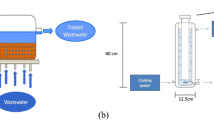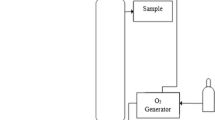Abstract
This paper comes out from the need to provide an improvement in the current oil refinery wastewater treatment plant (WWTP) aiming to generate water for reuse. The wastewater was pretreated and collected in the WWTP after the biological treatment unit (bio-disks) followed by sand filtration. Ozonation (ozone concentration from 3.0–60 mgO3 L−1), UV (power lamp from 15 to 95 W), H2O2 (carbon:H2O2 molar ratio of 1:1, 1:2, and 1:4), and two advanced oxidation processes (UV/O3 and UV/H2O2) were investigated aiming to reduce the wastewater organic matter and generate water with suitable characteristics for the reverse osmosis operation and subsequent industrial reuse. Even after the biological and filtration treatments, the oil refinery wastewater still presented an appreciable amount of recalcitrant organic matter (TOC of 12–19 mgC L−1) and silt density index (SDI) higher than 4, which is considered high for subsequent reverse osmosis due to membrane fouling risks. Experiments using non combined processes (O3, H2O2, and UV only) showed a low degree of mineralization after 60 min of reaction, although the pretreatment with ozone had promoted the oxidation of aromatic compounds originally found in the real matrix, which suggests the formation of recalcitrant compounds. When the combined processes were applied, a considerable increase in the TOC removal was observed (max of 95 % for UV/O3 process, 55 W, 60 mgO3 L−1), likely due the presence of higher amounts of reactive species, specially hydroxyl radicals, confirming the important role of these species on the photochemical degradation of the wastewater compounds. A zero-order kinetic model was fitted to the experimental data and the rate constant values (k, mgC L−1 h−1) ranged from 4.8 < k UV/O3 < 11 ([O3]0 = 30–60 mg L−1), and 8.6 < k UV/H2O2 < 11 (C:H2O2 from 1:1 to 1:4). The minimum and maximum electrical energy per order (E EO) required for 60 min of treatment were calculated as 5.4 and 81 Wh L−1, respectively, for UV/O3 (15 W, 60 mgO3 L−1) and UV/H2O2 (95 W, 1C:1H2O2). Good results in terms of water conditioning for reverse osmosis operation were obtained using UV/H2O2 process with initial molar ratio of 1 C:2 H2O2 (UV lamp 55 W) and 1 C:4 H2O2 (UV lamp 95 W), and total organic carbon (TOC) removals of 62 % (SDI15 = 1.8) and 74 % (SDI15 = 2.0) were achieved, respectively, after 60 min. The treated wastewater followed to the reverse osmosis system, which operated with an adequate flux of permeate, was very efficient to remove salt and generate a permeate water with the required quality for industrial reuse.






Similar content being viewed by others
References
Alhadidi A, Kemperman AJB, Schurer R, Schippers JC, Wessling M, van der Meer WGJ (2012) Using SDI, SDI+ and MFI to evaluate fouling in a UF/RO desalination pilot plant. Desalination 285:153–162
Aljuboury dDA, Palaniandy P, Aziz HBA, Feroz S (2016) Evaluation of the solar photo-Fenton process to treat the petroleum wastewater by response surface methodology (RSM). Environmental Earth Sciences 75:1–12
Andreozzi R, Caprio V, Insola A, Marotta R (1999) Advanced oxidation processes (AOP) for water purification and recovery. Catal Today 53:51–59
APHA, AWWA, WEF (2005) Standard methods for the examination of water and wastewater. American Public Health Association, American Water Works Association, Water Pollution Control Federation, Washington
ASTM-D4189-07 (2007) Standard test method for silt density index (SDI) of water. ASTM International, West Conshohocken, PA
Benatti CT, Tavares CR, Guedes TA (2006) Optimization of Fenton’s oxidation of chemical laboratory wastewaters using the response surface methodology. J Environ Manag 80:66–74
Benito-Alcázar C, Vincent-Vela MC, Gozálvez-Zafrilla JM, Lora-García J (2010) Study of different pretreatments for reverse osmosis reclamation of a petrochemical secondary effluent. J Hazard Mater 178:883–889
Bustillo-Lecompte CF, Knight M, Mehrvar M (2015) Assessing the performance of UV/H2O2 as a pretreatment process in TOC removal of an actual petroleum refinery wastewater and its inhibitory effects on activated sludge. Can J Chem Eng 93:798–807
Canonica S, Meunier L, von Gunten U (2008) Phototransformation of selected pharmaceuticals during UV treatment of drinking water. Water Res 42:121–128
Cater SR, Stefan MI, Bolton JR, Safarzadeh-Amiri A (2000) UV/H2O2 treatment of methyl tert-butyl ether in contaminated waters. Environmental Science & Technology 34:659–662
Coelho A, Castro AV, Dezotti M, Sant’Anna GL Jr (2006) Treatment of petroleum refinery sourwater by advanced oxidation processes. J Hazard Mater 137:178–184
Dias IN, Cerqueira AC, Sant’Anna GL, Dezotti M (2012) Oil refinery wastewater treatment in biofilm reactor followed by sand filtration aiming water reuse. Journal of water, reuse and desalination 2:84–91
Diya’uddeen BH, Rahim Pouran S, Abdul Aziz AR, Daud WMAW (2015) Fenton oxidative treatment of petroleum refinery wastewater: process optimization and sludge characterization. RSC Adv 5:68159–68168
EPA (2005) Determination of total organic carbon and specific UV absorbance at 254 nm in source water and drinking water—method 415.3. United States Environmental Protection Agency (USEPA), Washington DC
Glaze WH, Kang J-W, Chapin DH (1987) The chemistry of water treatment processes involving ozone, hydrogen peroxide and ultraviolet radiation. Ozone Sci Eng 9:335–352
Hasan DB, Abdul Aziz AR, Daud WMAW (2012) Oxidative mineralisation of petroleum refinery effluent using Fenton-like process. Chem Eng Res Des 90:298–307
Hwang J, Sang B, Yoo J, Lee K, Min B, Kim B (1994) Reuse of petroleum refinery wastewater using reverse osmosis membrane. Memburein 4:213–220
JIS (2015): Water conditioning for boiler feed water and boiler water, JIS B 8223–2015. Japanese Standards Association (JSA)
Lucas MS, Peres JA, Li Puma G (2010) Treatment of winery wastewater by ozone-based advanced oxidation processes (O3, O3/UV and O3/UV/H2O2) in a pilot-scale bubble column reactor and process economics. Sep Purif Technol 72:235–241
Misković D, Dalmacija B, Živanov Ž, Karlović E, Hain Z, Marić S (1986) An investigation of the treatment and recycling of oil refinery wastewater. Water Science & Technology 18:105–114
Mosset A, Bonnelye V, Petry M, Sanz MA (2008) The sensitivity of SDI analysis: from RO feed water to raw water. Desalination 222:17–23
Nicole I, De Laat J, Dore M, Duguet J, Bonnel C (1990) Use of U.V. radiation in water treatment: measurement of photonic flux by hydrogen peroxide actinometry. Water Res 24:157–168
Nogueira AA, Bassin JP, Cerqueira AC, Dezotti M (2016) Integration of biofiltration and advanced oxidation processes for tertiary treatment of an oil refinery wastewater aiming at water reuse. Environ Sci Pollut Res Int 23:9730–9741
Oenning Junior A, Pawlowsky U (2007) Evaluation of advanced technologies for water reuse in mechanical industry (in Portuguese). Engenharia Sanitaria e Ambiental 12:305–316
Poulopoulos SG, Arvanitakis F, Philippopoulos CJ (2006) Photochemical treatment of phenol aqueous solutions using ultraviolet radiation and hydrogen peroxide. J Hazard Mater 129:64–68
Quevedo N, Sanz J, Ocen C, Lobo A, Temprano J, Tejero I (2011) Reverse osmosis pretreatment alternatives: demonstration plant in the seawater desalination plant in Carboneras, Spain. Desalination 265:229–236
Saien J, Nejati H (2007) Enhanced photocatalytic degradation of pollutants in petroleum refinery wastewater under mild conditions. J Hazard Mater 148:491–495
Souza BM, Cerqueira AC, Sant’Anna GL, Dezotti M (2011) Oil-refinery wastewater treatment aiming reuse by advanced oxidation processes (AOPs) combined with biological activated carbon (BAC). Ozone Sci Eng 33:403–409
Staehelin J, Hoigne J (1982) Decomposition of ozone in water: rate of initiation by hydroxide ions and hydrogen peroxide. Environmental Science & Technology 16:676–681
Stepnowski P, Siedlecka EM, Behrend P, Jastorff B (2002) Enhanced photo-degradation of contaminants in petroleum refinery wastewater. Water Res 36:2167–2172
van Hoof SCJM, Minnery JG, Mack B (2001) Dead-end ultrafiltration as alternative pre-treatment to reverse osmosis in seawater desalination: a case study. Desalination 139:161–168
Weishaar JL, Aiken GR, Bergamaschi BA, Fram MS, Fujii R, Mopper K (2003) Evaluation of specific ultraviolet absorbance as an indicator of the chemical composition and reactivity of dissolved organic carbon. Environmental Science & Technology 37:4702–4708
Wong JM (2012): Water reuse for petroleum oil, product processing industries, Industrial Waterworld
Acknowledgments
The authors express their gratitude to the Brazilian agencies CAPES, CNPq, and Faperj and also to the technical staff of Petrobras S.A.
Author information
Authors and Affiliations
Corresponding author
Additional information
Responsible editor: Vítor Pais Vilar
Rights and permissions
About this article
Cite this article
Souza, B.M., Souza, B.S., Guimarães, T.M. et al. Removal of recalcitrant organic matter content in wastewater by means of AOPs aiming industrial water reuse. Environ Sci Pollut Res 23, 22947–22956 (2016). https://doi.org/10.1007/s11356-016-7476-5
Received:
Accepted:
Published:
Issue Date:
DOI: https://doi.org/10.1007/s11356-016-7476-5




